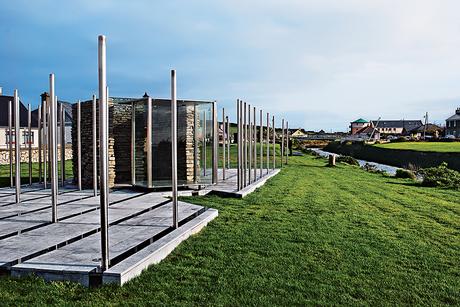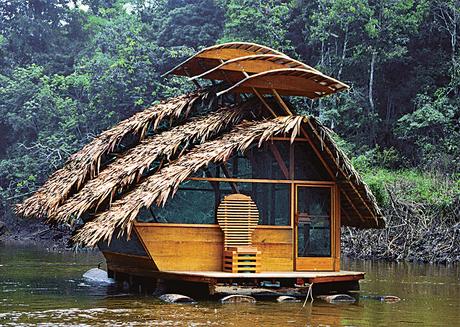
Spirit of Place/Spirit of Design, a program conceived by The Catholic University of America architecture professor Travis Price, takes students to out-of-the way settings to craft monuments that reflect local folklore.
Image courtesy of Oro Editions.That Travis Price defines himself as a storyteller is not, on its face, unusual; “every architect is,” he acknowledges. But the stories that Price favors—mythological tales of bygone civilizations, like those of the Incas and the ancient Greeks—set him apart from his peers. For more than two decades, as a professor of architecture at The Catholic University of America, in Washington, D.C., he has been taking small groups of students to the birthplaces of these myths and recasting the ancient stories into modern structures.
The point of this design-build program, called Spirit of Place/Spirit of Design, is to produce a generation of architects unfazed by cultural boundaries. “To dig deep into cultures, I can’t go to the mall,” says Price, who runs his firm, Travis Price Architects, from a cluttered office in Georgetown. “That’s just consumer culture.”
Price has long been a student of ancient civilizations. A peripatetic childhood in a military family, with stops in Georgia, Germany, and Panama, instilled in him an insatiable curiosity about people and cultures. Those interests carried over into his architectural studies at the University of New Mexico, where he reportedly coined the term “passive solar” after studying how melting snow glides off the terraces of the prehistoric pueblo structures in Chaco Canyon.

In 2005, in coastal Ireland, the result was a multi-part tribute in stone and steel to the mythical Children of Lir, who were turned into swans for 900 years.
Image courtesy of Oro Editions.Spirit of Place has its roots in an adventure to Ealue Lake, in northwestern British Columbia, that Price undertook in 1991 with Wade Davis, an author, explorer, and anthropologist, who owns a lodge there. Price quickly became infatuated with the folklore of the region, the artifacts of indigenous tribes, and the possibilities for off-the-grid living. Before the two knew it, a new course was starting to take shape. Davis offered to lecture to Price’s class, and Price would gather a group of students to bring to the lake, where they would assemble a structure in the wilderness.
Price successfully pitched the concept to the dean of Catholic University’s School of Architecture and Planning. “Now I had the task of getting students to sign up,” he says. “I wasn’t sure that many would be interested.” After Davis’s lecture, 133 students registered. “Turns out, I had a different problem: narrowing that down to nine kids.”
Price uses the class to prepare his students for a nine-day trip to a remote location, where they will work with local craftspeople to build a monument that melds the ancient with the modern. The first month of class is devoted to building a cultural understanding of the area they’ll be visiting, whether Nepal, Ireland, or Finland. The following month, each student builds a model and presents it to the class. Price then helps the students merge their ideas into one design. The final weeks of the course are devoted to drafting detailed plans and a meticulous budget, accounting for the cost of each screw. The blueprint is then shared with their host, who collects the necessary materials before the students arrive.

Price returned to Ireland in 2007—this time to Blacksod Bay in County Mayo, a departure point for many who fled the country during the famine of the 1850s. The Temple of Tides was conceived as a monument to those who left as well as a celebration of new population growth.
Image courtesy of Oro Editions.Upon reaching their destination, the team members spend the first day meeting with the local craftspeople and taking in the surroundings. The first two building days are devoted to laying a foundation and erecting walls. On the third building day, exhaustion begins to creep in; the students work in teams from 7 a.m. to 7 p.m., with only two brief breaks. The last two days are reserved for detailing and other finishing touches, such as landscaping. On the last day, the group throws a dedication party and invites the local community to give feedback.
The first two Spirit of Place expeditions saw Price returning with Davis to Ealue Lake, where students designed an angular wooden temple and, the following year, a pair of cheekily irreverent outhouses. Subsequent destinations typically have been chosen by way of an invitation from a local host or a collaboration with a friend, such as Davis. In 1999, inspired by Davis’s 1996 book about the Amazon, Price developed a Spirit of Place trip to Peru—the first to venture beyond British Columbia and California. Price and his students designed a floating house that references huts that the indigenous people built for themselves, intricately weaving palm leaves into thatched roofs.
In 2001, Ian Baker, an author and explorer, wrote to Price to see if he’d like to help design an ayurvedic retreat and a meditation structure, in Nepal. Building on the outskirts of Nagarjun Hill—home to a famous Buddhist stupa, a mound in which sacred relics are buried—was no small task, but Price, who holds a bachelor’s degree in Western philosophy, couldn’t resist an opportunity of such metaphysical significance.

The floating room emulates local huts with its steep thatched roof that easily sheds the region’s punishing rains.
Image courtesy of Oro Editions.“It was complete with nāgas,” snake deities revered in Hindu and Buddhist mythology, “and a christening of the building site by local priests—ironically, with Coca-Cola,” he says.
Since then, Price has taken Spirit of Place to Finland, to Ireland multiple times, and back to Nepal. While the settings are steeped in ancient traditions, the structures that the students leave behind are always modern. The idea, Price writes, in the introduction to The Mythic Modern, his 2012 book about the program, is to “bring our human story and nature’s power back into modern architecture.”
The program’s enduring popularity is tied in large part to that of Price himself; his thoughtful, philosophical nature and deep understanding of time and place have made him an inspirational figure to generations of aspiring architects. “As a teacher, he is both tough and compassionate, provocative and receptive, explosive and yet, when appropriate, as still and quiet as a mountain,” Davis says. Kelly Davies Grace, an associate at Price’s firm, who went on two Spirit of Place expeditions as a student at Catholic University, observes that her mentor’s “teaching philosophies and practice philosophies are one and the same. He is a master of the metaphor.”
The students Price invites to accompany him on these adventures “are not just partaking in some poetic mélange,” he says. “You learn to listen to a different language, the meaningfulness of a structure. The students come back as travelers, not tourists. They’re a piece of the living history.”
